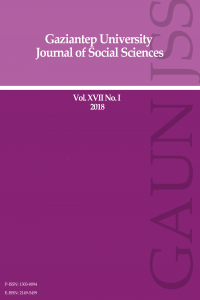Abstract
During
the early years of language acquisition, children may use a word in a wide
range of contexts, which is called as overextension
in research agenda. Barrett (1991) hypothesizes that if a word like dog is overextended not only for
referring to dogs of all sizes, but also for referring to cats, horses, or cows,
then the overextension is likely to be exhibited not only in the child's
production of that word, but also in the child's comprehension of the word. Based
upon this hypothesis, the focal point of the present study is to test the
overextension issue in terms of both production and comprehension perspectives.
The subjects (N=10) aged 2;2 to 4;0 have
been experimented through picture-naming and picture-pointing tasks in order to
reveal whether there is a symmetry between these two stances. The results of
this experiment are inconsistent with the views foreseeing any parallelism between
the overextension in comprehension and production. Rather, it has been observed
that children have a tendency to overextend the words in production more often
than in comprehension. Nor does it supply evidence for overextensions mostly
occurring in both phases at very early ages.
References
- Reference1: Barrett, M. (1991). The multi-route model of early lexical development. University of London 7 (2), 123-136.
- Reference2: Clark, E.V. (2004). How language acquisition builds on cognitive development. Trends in Cognitive Science 8 (10), 472-478.
- Reference3: Clark, E. V. (2009). First language acquisition. Cambridge University Press.
- Reference4: Elsen, H. (1994). Phonological constraints and overextensions. First Language 14. 305-315.
- Reference5: Gelman, S.A., Croft, W., Fu, P., Clausner, T., & Gottfried, G. (1998). Why is a pomegranate an apple? The role of shape, taxonomic relatedness, and prior lexical knowledge in children's overextensions of apple and dog*. Child Lang., 25. Cambridge University Press, 267-291.
- Reference6: Kuczaj, S. A. (2001). The worlds of words: Thoughts on the development of a lexicon. In Marytn Barrett (Ed.), The Development of Language (pp. 133-159). Sussex, UK: Psychology Press Ltd.
- Reference7: Nelson, K. (2008). Concept, Word and Meaning in Brief Historical Context. Journal of Anthropological Psychology No. 19, 28-31.
- Reference8: O’Grady, W., & Cho, S. W. (2001). First language acquisition. In W. O’Grady, J. Archibald, M. Aronoff, and J. Rees-Miller (Eds.), Contemporary linguistics: An introduction (pp. 409-448). Boston: Bedford/St. Martin’s.
- Reference9: Pacesova, J. (1987). Semantic Development: Theory and Application. SBOBNfK PBACI FILOZOFICKE FAKULTY BRNEN9KE UNIVBRZITY STUDIA MINORA FACULTATI8 PHILOSOPHICAE UNIVEBSITATI8 BBUNENSIS A 35.
- Reference10: Peccei, J. S. (2006). Child language: a resource book for students. Psychology Press. Rescorla, Leslie A. (1980). "Overextension in Early Language Development." Journal of Child Language 7, no. 2: 321-335, doi:10.1017/S0305000900002658.
- Reference11: Thomson, J. R. & Chapman, R. S. (1976). Who is ‘Daddy’ revisited: the status of two-year-olds' over-extended words in use and comprehension. Journal of Child Language, 4, pp 359-375. doi:10.1017/S0305000900001744.
Abstract
Dil ediniminin ilk yıllarında çocuklar, araştırma gündeminde aşırı genişletme olarak adlandırılan, bir kelimeyi çok çeşitli bağlamlarda kullanma eğilimi göstermektedirler. Barrett (1991) eğer köpek kelimesi yalnızca tüm boyutlardaki köpeklere işaret etmek için değil de aynı zamanda kediler, atlar ya da inekler için de aşırı genişletiliyorsa, o zaman aşırı genişletme durumunun çocuğun o kelimenin yalnızca üretiminde değil aynı zamanda kelimeyi anlamasında da sergileneceği varsayımında bulunmaktadır. Bu varsayıma dayalı olarak, mevcut çalışmanın odak noktası aşırı genişletme problemini anlama ve üretme perspektifleri açısından test etmektir.Bu iki olgu arasında herhangi bir simetri olup olmadığını ortaya çıkarmak amacıyla 2 yaş 2 ay'dan 4 yaşa kadar olan deneklere (n=10) resim adlandırma ve resim işaret etme görevleri yoluyla deney uygulanmıştır. Bu deneyin sonuçları, anlama ve üretmedeki aşırı genişletmeler arasında herhangi bir paralellik öngören görüşlerle tutarsızdır. Daha ziyade, çocukların kelimeleri anlamadan ziyade üretme basamağında daha fazla aşırı genişletme eğiliminde oldukları gözlemlenmiştir. Bu çalışma, her iki aşama açısından çoğunlukla daha erken yaşlarda görülen aşırı genişletmeler için de kanıt sağlamamaktadır.
Keywords
References
- Reference1: Barrett, M. (1991). The multi-route model of early lexical development. University of London 7 (2), 123-136.
- Reference2: Clark, E.V. (2004). How language acquisition builds on cognitive development. Trends in Cognitive Science 8 (10), 472-478.
- Reference3: Clark, E. V. (2009). First language acquisition. Cambridge University Press.
- Reference4: Elsen, H. (1994). Phonological constraints and overextensions. First Language 14. 305-315.
- Reference5: Gelman, S.A., Croft, W., Fu, P., Clausner, T., & Gottfried, G. (1998). Why is a pomegranate an apple? The role of shape, taxonomic relatedness, and prior lexical knowledge in children's overextensions of apple and dog*. Child Lang., 25. Cambridge University Press, 267-291.
- Reference6: Kuczaj, S. A. (2001). The worlds of words: Thoughts on the development of a lexicon. In Marytn Barrett (Ed.), The Development of Language (pp. 133-159). Sussex, UK: Psychology Press Ltd.
- Reference7: Nelson, K. (2008). Concept, Word and Meaning in Brief Historical Context. Journal of Anthropological Psychology No. 19, 28-31.
- Reference8: O’Grady, W., & Cho, S. W. (2001). First language acquisition. In W. O’Grady, J. Archibald, M. Aronoff, and J. Rees-Miller (Eds.), Contemporary linguistics: An introduction (pp. 409-448). Boston: Bedford/St. Martin’s.
- Reference9: Pacesova, J. (1987). Semantic Development: Theory and Application. SBOBNfK PBACI FILOZOFICKE FAKULTY BRNEN9KE UNIVBRZITY STUDIA MINORA FACULTATI8 PHILOSOPHICAE UNIVEBSITATI8 BBUNENSIS A 35.
- Reference10: Peccei, J. S. (2006). Child language: a resource book for students. Psychology Press. Rescorla, Leslie A. (1980). "Overextension in Early Language Development." Journal of Child Language 7, no. 2: 321-335, doi:10.1017/S0305000900002658.
- Reference11: Thomson, J. R. & Chapman, R. S. (1976). Who is ‘Daddy’ revisited: the status of two-year-olds' over-extended words in use and comprehension. Journal of Child Language, 4, pp 359-375. doi:10.1017/S0305000900001744.
Details
| Subjects | Creative Arts and Writing |
|---|---|
| Journal Section | Linguistics |
| Authors | |
| Publication Date | January 31, 2018 |
| Submission Date | September 13, 2017 |
| Acceptance Date | October 25, 2017 |
| Published in Issue | Year 2018 Volume: 17 Issue: 1 |


